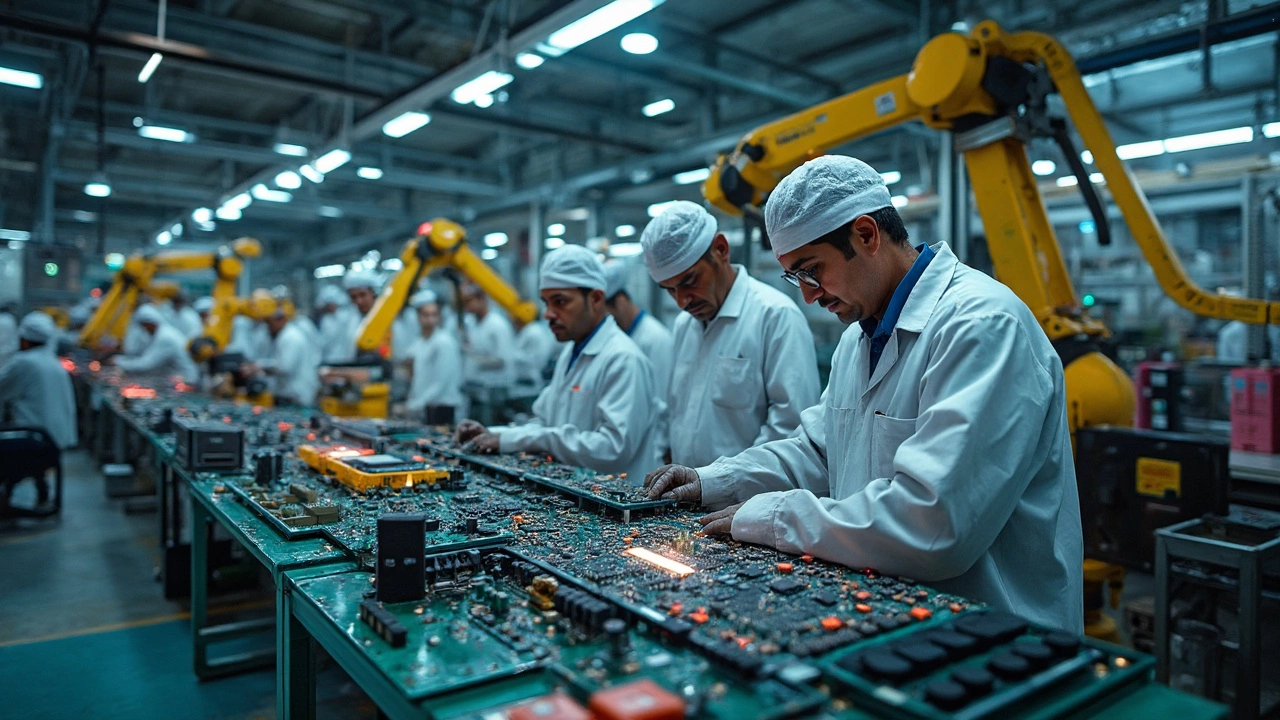Which Country Tops Electronics Manufacturing? The Surprising Truth

Ever wondered which nation claims the crown in electronics manufacturing? No, it's not a quick Google search kind of answer. The world's largest producer of electronics is China, hands down. With its massive factories and skilled workforce, China dominates the scene, churning out everything from smartphones to high-tech gadgets. But is the dragon's grasp loosening? Well, that's where India comes into the picture.
India is rapidly becoming a heavyweight contender in the electronics world. The country's electronics production industry has grown by leaps and bounds, thanks to insightful government policies and a booming tech-savvy population. The 'Make in India' initiative plays a key role, enticing global giants to set up shop and manufacture within Indian borders. It's not just hype; it's a calculated move to boost local production and employment.
- The Global Leader in Electronics Manufacturing
- Why India is a Key Player
- What Makes India Stand Out?
- Challenges in India's Electronics Industry
- Countries Rivaling for the Top Spot
- The Future of Electronics Manufacturing
The Global Leader in Electronics Manufacturing
China, the juggernaut of electronics manufacturing, stands tall with its unmatched production capability. The country’s success story is no accident. It boasts a well-oiled machine of supply chain networks, abundant workforce, and cutting-edge technology. Picture this: nearly every other electronic device you own probably took its first breath in a Chinese factory.
But why is China the go-to place for electronics? First, low labor costs. Imagine producing devices at a fraction of the cost compared to Western factories. Then, there’s infrastructure. China has mega factories that can pop out thousands of units daily without breaking a sweat. Plus, it nails efficiency by having everything—from raw materials to assembly lines—in close proximity, slashing down time and cost.
Another game-changer? Government backing. Huge investments in technology and strong support for tech firms mean companies can innovate without worrying too much about the cost. And we can't forget the huge market. With over a billion people keen on tech, there's both a supply and demand paradise.
You might wonder how this affects other players like India, which are trying to climb the ranks. Well, India’s making strides but China's still the king, with around 70% of the global electronics market share locked in.
India, on the other hand, while growing fast, is learning from China's playbook, adapting where it can while tackling its challenges. The race isn't over, but China’s lead is a benchmark others can aim for—or better yet, surpass.
Why India is a Key Player
India is seriously stepping up its game in the electronics manufacturing world, and it's not by accident. One of the big reasons India is standing out is because of its strategic initiatives, like the 'Make in India' campaign. This initiative has been successful in attracting top-tier tech companies to set up manufacturing units here. We're talking big names like Apple and Samsung, who are keen on riding the wave of India's growing manufacturing prowess.
What helps India is its massive pool of skilled engineers and tech professionals. With approximately 1.5 million engineers graduating each year, India provides a ready workforce for the electronics industry. And let's not forget labor costs. Compared to other countries, India offers cost-effective labor, which is a huge plus for companies looking to manufacture products without breaking the bank.
Another crucial factor is the supportive government policies aimed at boosting the manufacturing sector. The Production Linked Incentive (PLI) scheme has been a game changer, offering financial incentives to companies that increase their domestic production. This scheme has already attracted investments worth billions and is creating thousands of jobs.
Here's a quick look at some impressive numbers:
| Year | Value of Electronics Production in India (USD Billion) |
|---|---|
| 2018 | 68 |
| 2021 | 100 |
But wait, there's more. India's large domestic market is a magnet for electronics companies. With a young, tech-savvy population, the demand for electronic gadgets is booming. This gigantic market not only benefits manufacturers with sales but also motivates them to innovate and expand their product lines.
In short, India is not just a copycat in the global electronics manufacturing arena; it's shaping up to be an innovator and leader. With the right mix of strategy, skill, and scalability, India is definitely one of the key players stirring up the global market.
What Makes India Stand Out?
India's electronics manufacturing scene is buzzing, and there's plenty to talk about. So, what’s giving India an edge in the electronics manufacturing game? First things first, India's got a massive pool of young, tech-savvy talent. With a large number of engineering grads entering the workforce every year, the skillset needed for this industry is right at hand.
Another biggie is the 'Make in India' initiative. This government-backed campaign aims to turn India into a global manufacturing hub. It’s cut through red tape and thrown open doors for foreign investments. Companies like Apple and Samsung have set up manufacturing units, giving the local scene a serious boost.
You also can't ignore India's cost advantage. Labor here is cheaper than in China, which makes producing electronics more cost-effective. Plus, India's developed a solid electronics manufacturing infrastructure over the past few years. Special Economic Zones (SEZs) and mega-production facilities are popping up, offering everything from raw materials to logistics support.
And let’s talk incentives. The Indian government offers various financial perks to attract electronics manufacturers. These include tax breaks and easier access to capital. This not only helps international brands but also bolsters local startups, giving them room to grow.
India's rise in the electronics realm isn't just about policy and skills; it's also about an expanding market. With a billion-plus consumers, many of whom are tech enthusiasts, there's a huge domestic demand for electronics. This local market presence acts as a strong foundation for future growth in the electronics industry.
Of course, there's still some ground to cover, like beefing up the supply chain and addressing any bureaucratic bottlenecks. But if any country is poised to shake up the world's electronics market, it's India.

Challenges in India's Electronics Industry
Sure, India’s electronics manufacturing is on the up and up, but it's not all smooth sailing. Let's talk about some of the hurdles they're facing. First up, infrastructure. Now, compared to other heavyweights, India's infrastructure needs a bit of a boost. Picture it like this: with roads that don't always make the cut and unreliable power supply, it adds extra complications for manufacturers.
Then there's the supply chain. While India's got a knack for software and IT services, when it comes to hardware, things are a bit more complex. Dependence on imports for certain components like semiconductors is a biggie. It means higher costs and potential delays, especially when global supply chain issues crop up.
Manufacturing skill level is another bump in the road. India’s got a large workforce, no doubt, but the expertise level in high-tech electronics manufacturing? It’s still catching up compared to more seasoned countries. Skilled workers are crucial when you're aiming to up the ante in electronics manufacturing.
On the regulatory front, India's policies have been evolving, but there’s room for more simplification. Bureaucracy can sometimes slow down the 'Make in India' push, making it a bit complicated for companies looking to swiftly set up operations.
Lastly, let's not forget the competition. Other countries aren't sitting still. They're keenly watching and stepping up their game too. India needs to keep innovating to stay in the race and grab a bigger piece of the global electronics industry pie.
Countries Rivaling for the Top Spot
While China is the undisputed leader in electronics manufacturing, several other countries are jostling for a piece of the pie, trying to close the gap and enhance their own industries. Among them, India stands out with its ambitious goals and growth rate, but it's not alone in this race.
Vietnam is one of the key players that has seen a significant increase in its electronics output, thanks to its strategic geographic position and investment-friendly environment. Big tech names like Samsung and LG have set up large-scale operations here, boosting its credibility and exporting prowess.
Then there's South Korea, which, despite being smaller in size compared to China or India, hosts powerhouse companies like Samsung and LG. It’s not just about production, though; innovation is at the heart of Korea’s strategy. This focus on cutting-edge technology keeps it in the competitive mix.
Meanwhile, the United States remains a strong competitor in the high-tech sector. Although it doesn't produce at the volume seen in Asia, its focus is on advanced technology and innovation. Companies like Apple and Intel are constantly pushing the boundaries, making the US a critical player in high-value electronics.
Japan, once the electronics kingpin, is also worth a mention. While its mass production has slowed, its expertise in precision equipment and innovative technology keeps it relevant. "Japan's strength lies in its ability to produce high-quality components and electronics," notes Kevin O’Leary, business analyst at TechLink.
"The synergy between quality and innovation defines Japan's edge in a competitive market."
This competitive landscape ensures that the electronics industry remains dynamic, with each country striving to enhance its capabilities. It's a thrilling contest to watch, with each of these nations bringing unique strengths and strategies to the table.
The Future of Electronics Manufacturing
The future of electronics manufacturing is buzzing with possibilities. With advances in technology and changing global dynamics, it's hard to predict exactly what will happen, but some trends are certainly emerging. Tech giants are no longer just focusing on making things faster or shinier; they're looking at sustainability and smarter processes.
India's electronics industry is set to keep climbing the ladder thanks to its focus on renewable energy. As eco-friendly manufacturing becomes the norm, nations leading in sustainable practices will likely dominate the industry. Solar-powered factories? Check. Smart grids for efficient energy use? Double check.
But it's not all about keeping it green. Automation and AI are reshaping the game as well. Robots are becoming a mainstay on production lines, performing tasks with precision and speed that humans simply can't match. While this sparks debates about job losses, the flip side is tons of new roles focusing on tech development and maintenance.
India's massive young workforce is a wild card in this mix. With initiatives to upskill millions in tech areas, the country is prepping a generation ready to take on the electronics challenge. Educational partnerships with tech companies are also on the rise, emphasizing real-world skills over textbook learning.
Let's not forget the constant shift in demand dynamics. As the world continues to innovate, the need for more sophisticated electronics grows. Whether it's smart home devices or cutting-edge healthcare tech, countries at the forefront of R&D will have the advantage.
| Year | Global Electronics Market Size (USD Trillions) |
|---|---|
| 2023 | 4.2 |
| 2025 | 4.7 |
| 2028 | 5.4 |
This hustle isn't just about making money; it's about reshaping life as we know it. While China remains the top dog now, with India ramping up its game, the world is in for an exciting ride in the electronics sector.